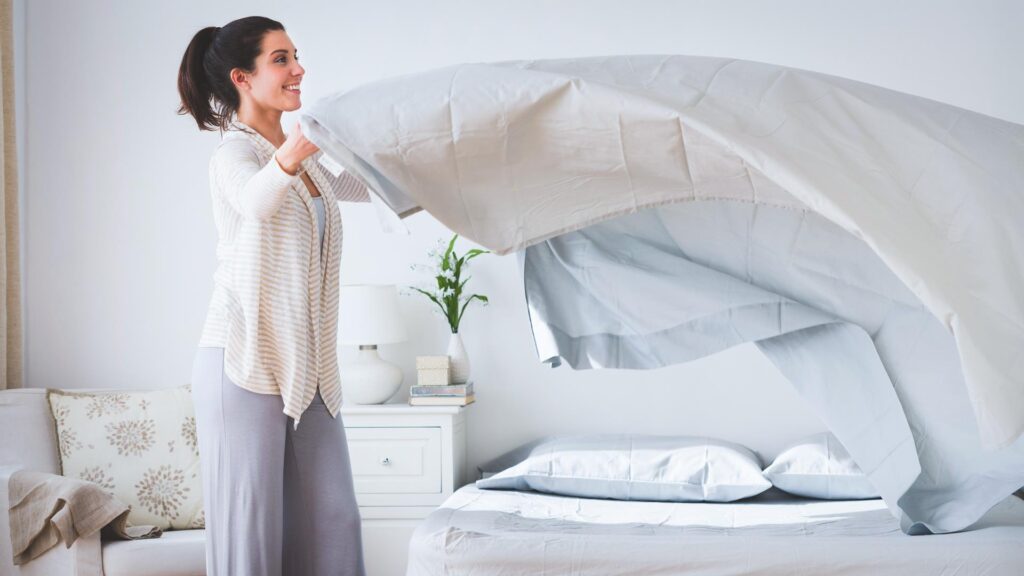Sleep Talk Blog, Care And Maintenance, Inspire me
4 Different Types Of Bedding Materials - The Benefits
While your mattress supports you during sleep and provides pressure relief, your bedding keeps you warm and gives you something to cuddle.
Bedding plays as important a role as your mattress for bedtime comfort, yet many people think nothing of it when making a purchase.
It's a mistake to focus only on duvet togs and pillow firmness when picking bedding – the materials also matter for feel.
This article explores different bedding materials to help you choose the right bedding for a comfortable night's sleep.
Bedding materials
Duvets and pillows are available with the same fillings, and the pillow firmness or duvet tog is determined by the quantity of material and how densely it's packed.
Here are the primary materials:
Hollowfibre
Hollowfibre is a polyester yarn akin to cotton wool. The polyester fibres trap air and create a lofty duvet that is lightweight yet incredibly warm.
The low price point of hollow fibre duvets and pillows makes them a popular option, and many people rate them higher than other bedding types because they are breathable and lightweight while trapping heat.
Hollowfibre is hypoallergenic and recyclable, but it isn't biodegradable. At the end of its life, it is usually made into clothing.
Microfibre
Microfibre is another type of polyester yarn, but it comprises tightly packed polyester strands with nylon to create fabric strips.
Microfibre filling is a vegan-friendly down and feather alternative. It offers similar sleeping characteristics, including excellent loftiness and airiness, mimicking the way down-and-feather filling puffs up and compresses with pressure.
The downside to microfibre is it is less breathable than hollow fibre, but not by much.
Down and feather
Down and feather is a traditional bedding filling. It sets the standard for loftiness, and many people swear by it for comfort. However, cruelty concerns over the down industry mean it has fallen out of favour with modern consumers.
Down and feather also have practical disadvantages, like low breathability, the ability to hold moisture, and feather stems penetrating the cover.
However, the most significant disadvantage to down and feather is it isn't hypoallergenic, so if you are susceptible to sneezing fits, it isn't for you.
Memory foam

Exclusive to pillows, memory foam offers unbeatable support in medium-firm and firm pillows, contouring to your head for optimal comfort.
Memory foam's big drawback is it retains heat, so look for a pillow with a breathable outer cover or charcoal-bamboo or graphite memory foam.
Choosing the right bedding
Pillows
The most important thing about a pillow is its firmness because it determines whether you will be most comfortable sleeping on your back, side, or front.
Here's the essential advice:
- Back sleeper – get a medium-firm pillow
- Side sleeper – get a firm pillow
- Front sleeper – get a soft pillow
You only need one pillow when it's the right firmness. However, if you must sleep with two pillows, mix and match a firm pillow and a soft pillow.
Duvets
There are more things to consider with duvets than pillows. The primary consideration is the tog, which determines how warm it is.
Here's what we recommend:
- Summer sleeping – up to 4.5 togs
- Winter sleeping – Over 12.5 togs
- All-season sleeping – 10.5 togs
All-season duvets are a much more popular option than winter and summer duvets because they save space and money. However, you will benefit from a cooler duvet in summer and a thicker duvet in winter, so it's better to have both.
Also, consider whether you are a hot or cold sleeper – hot sleepers should err on the cooler side for optimal bedtime comfort.
With down and feather duvets, fill power also matters. A higher fill power signifies higher-quality down filling – making it more insulating and resilient. A 900-fill power is as good as it gets, but anything over 550 is considered good quality.
We like hollow fibre duvets and pillows because they are breathable, but memory foam pillows are also great for support.

